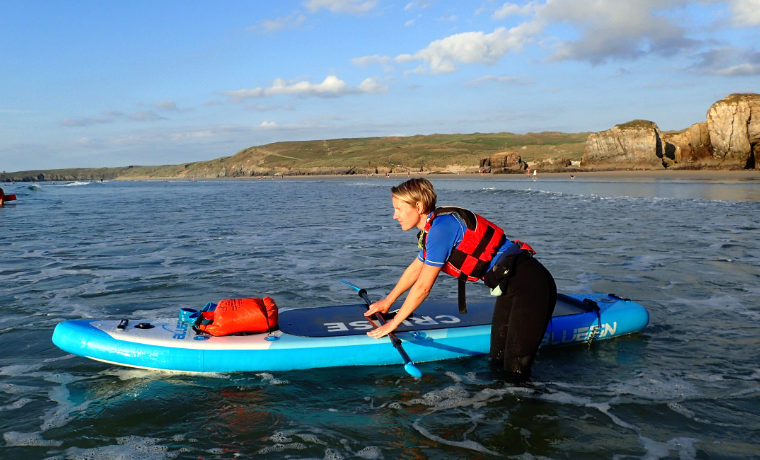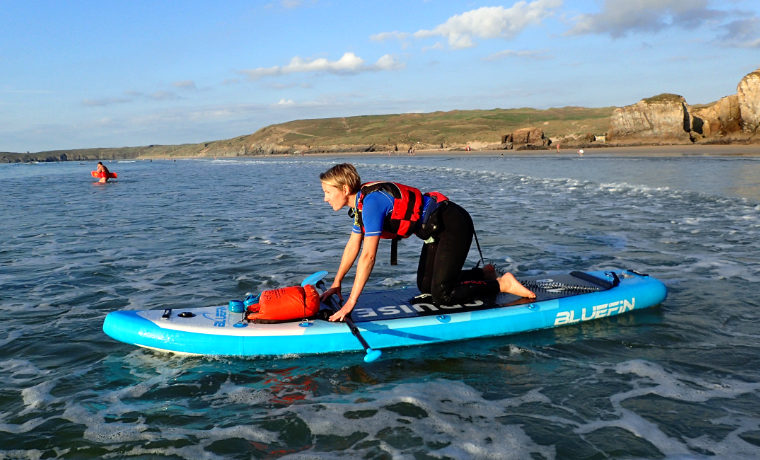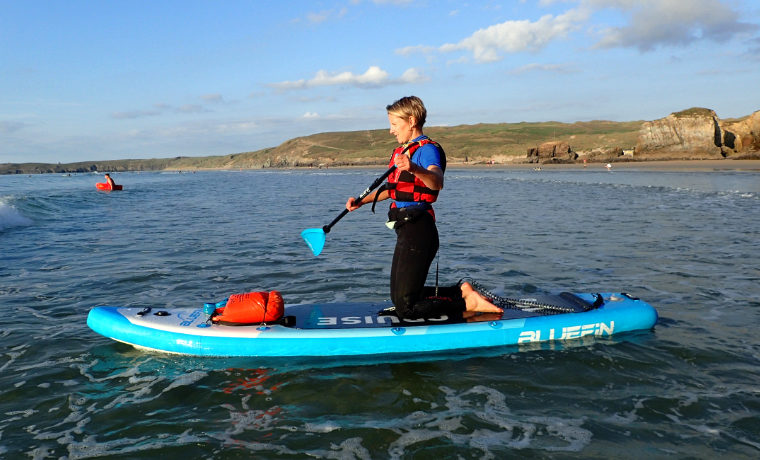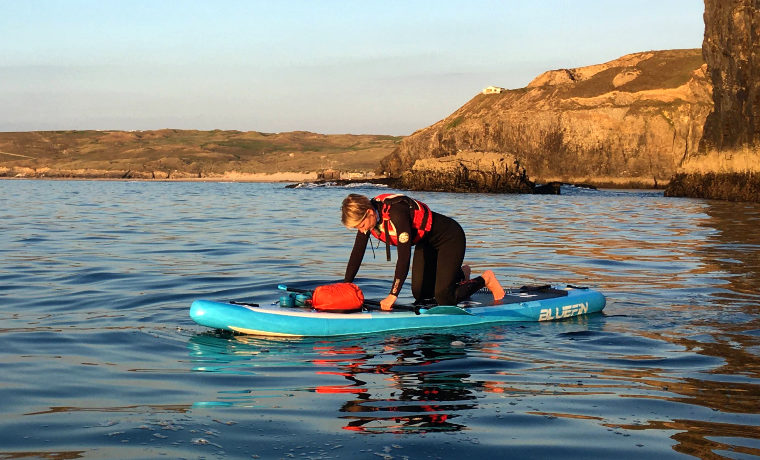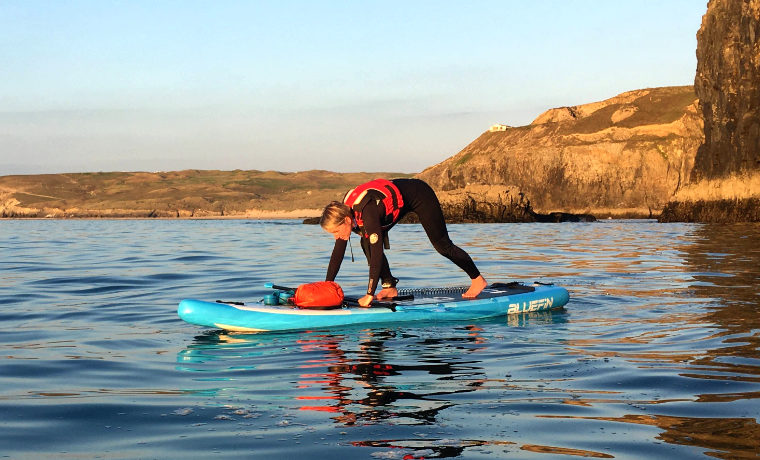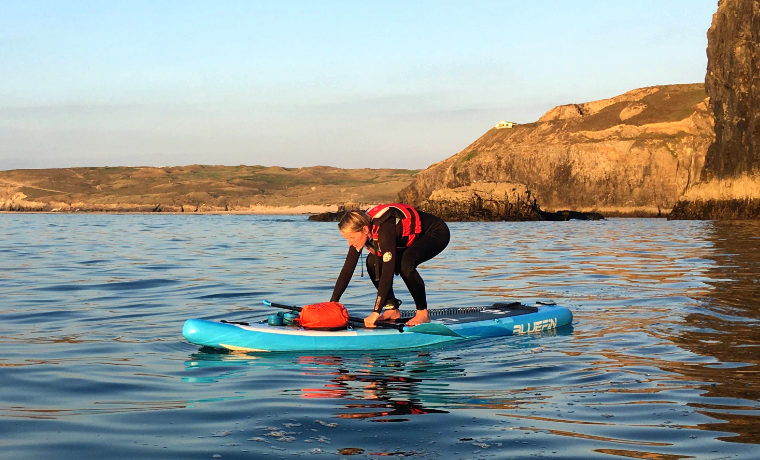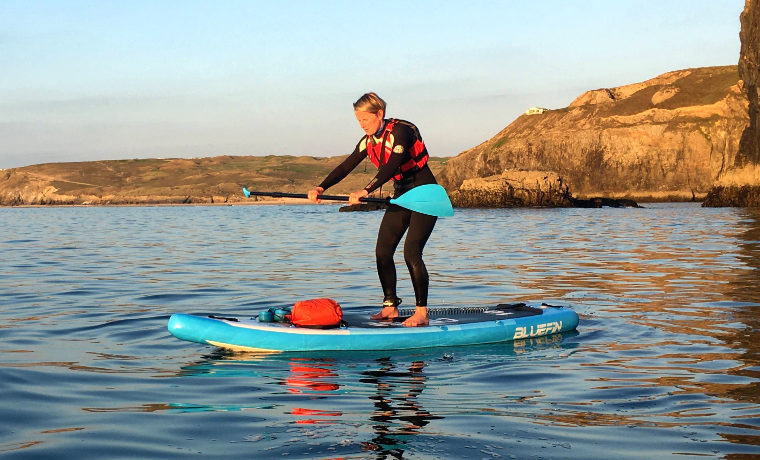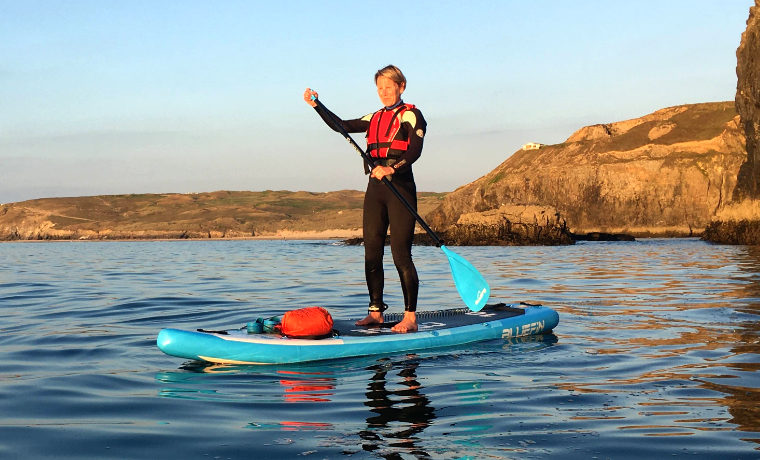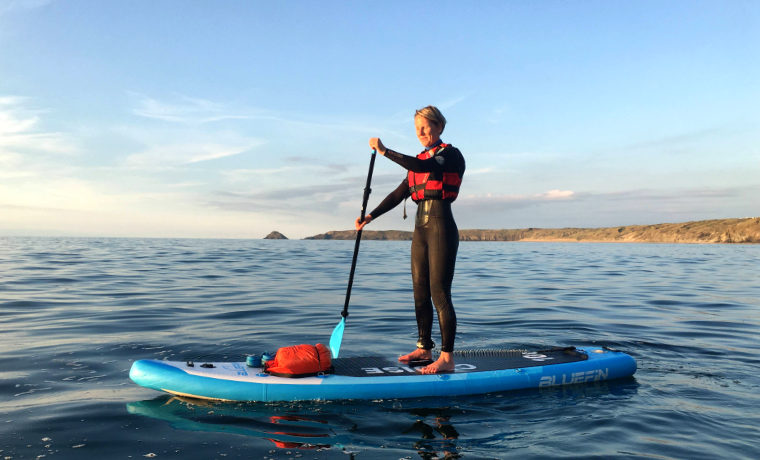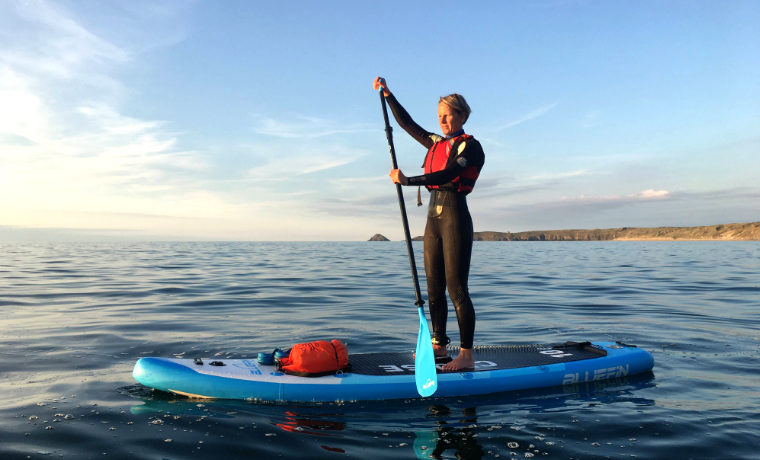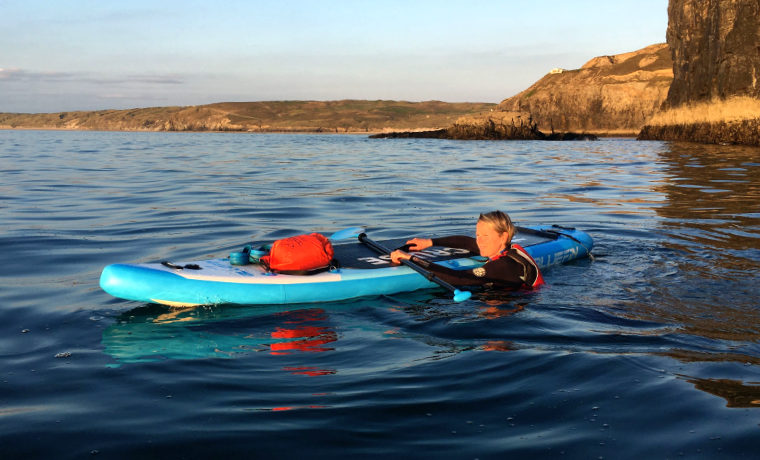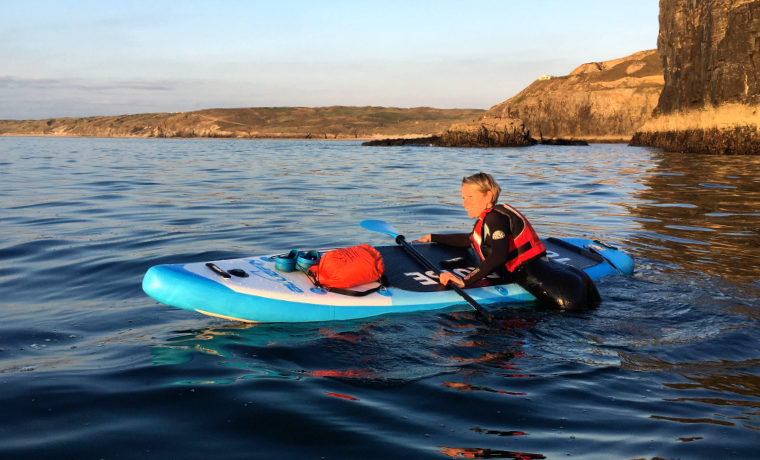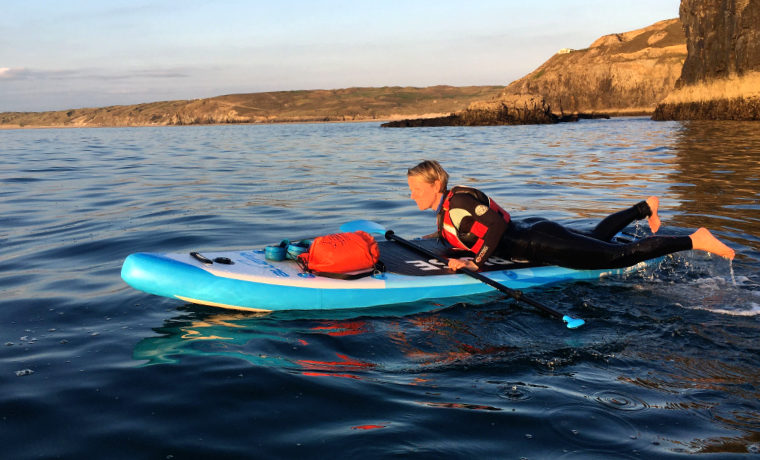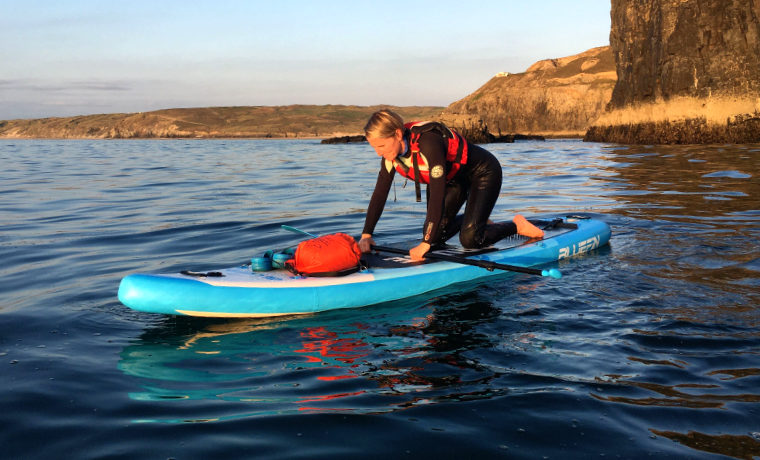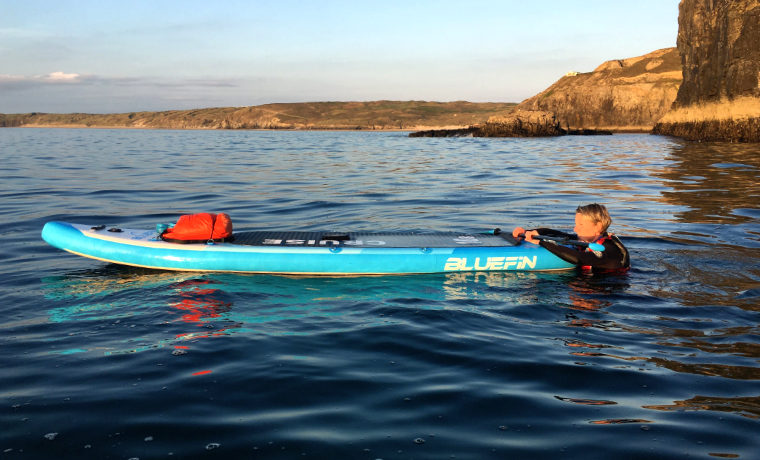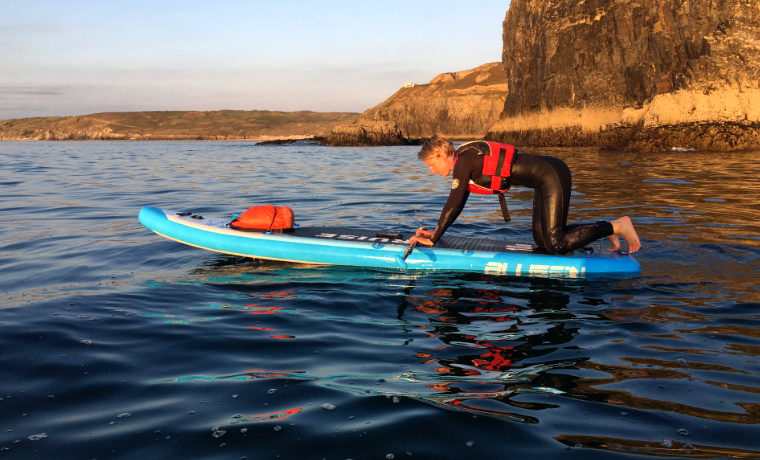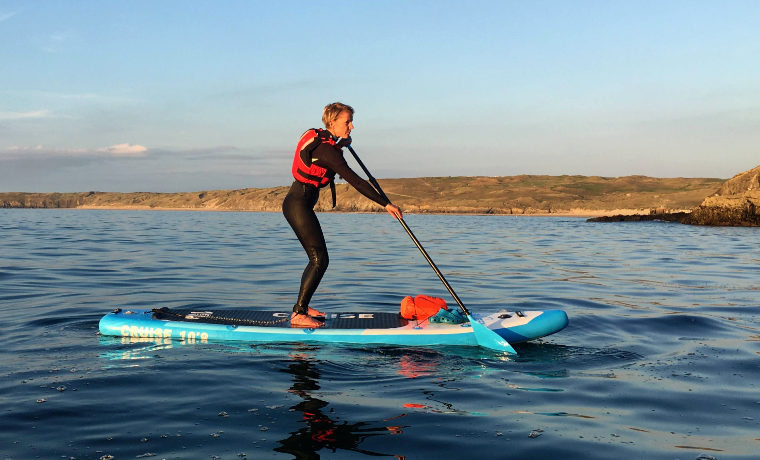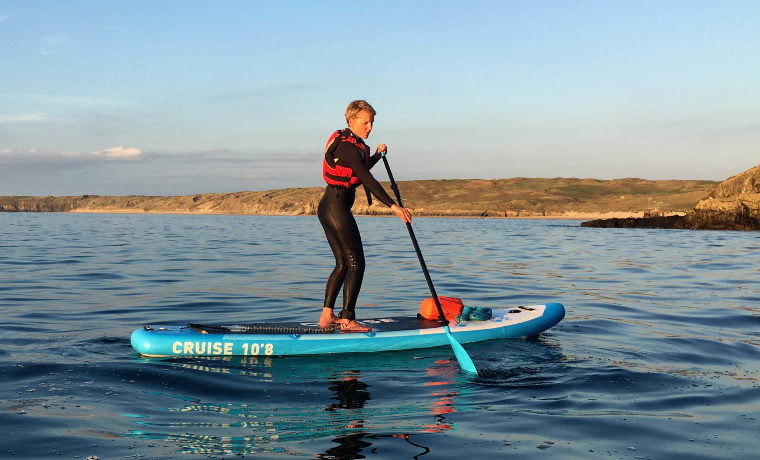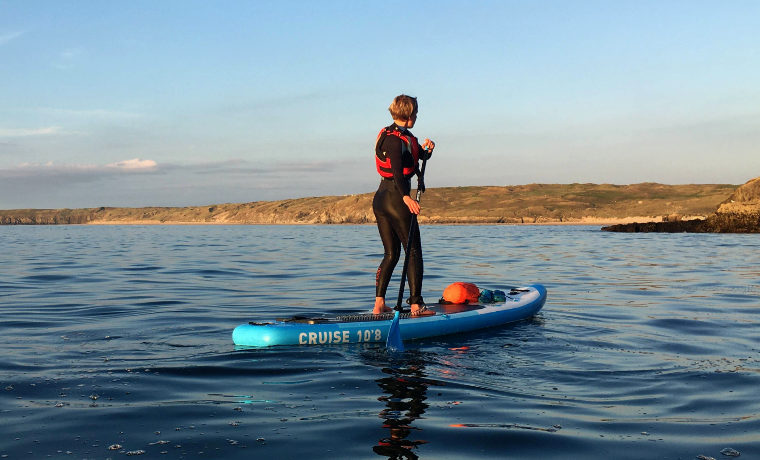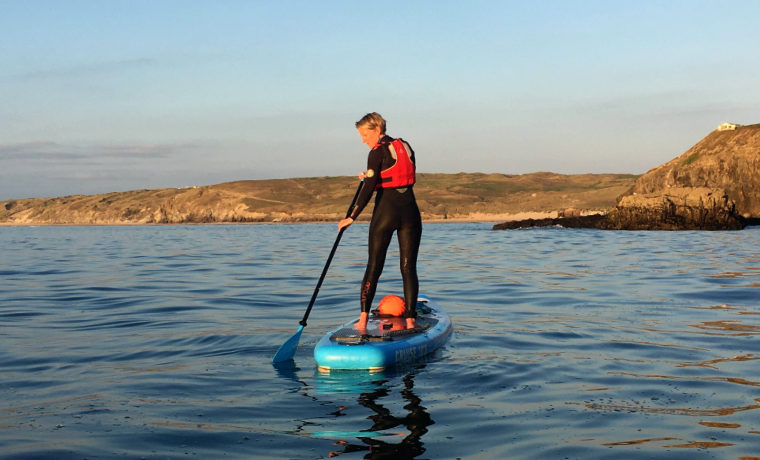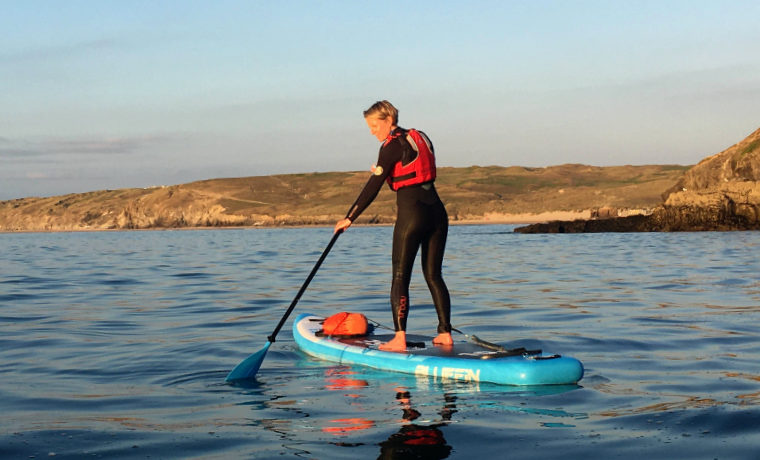If you’ve ever stared in wonder at someone paddle boarding and thought to yourself, “I want to do that!”, this guide to paddle boarding for beginners is for you!
In this article, I’m going to explain how to stand up paddle board, covering all you need to know to make your first forays out onto the water. And don’t worry – paddle boarding is much easier than it looks!
- Equipment for paddle boarding
- How to paddle board for beginners – getting ready for launch
- How to stand up paddle board for beginners
- Paddle boarding tips and tricks for beginners
- Paddle boarding for beginners – wrapping up
Equipment for paddle boarding
Paddle boarding is quite a specialist activity, so you’ll need a few items of essential paddle boarding gear to get started. Beginners should probably hire or borrow their paddle boarding equipment to save on buying stuff that may be unnecessary or becomes redundant once your skills improve.
So, the SUP equipment you need to start paddle boarding includes:
A paddle board
Paddle boards come in all shapes and sizes. Wider, medium-length boards are best for beginners as they’re more stable and easier to stand on. Leave sleek racing boards for the experts. Otherwise, you could find yourself spending more time in the water than on it! Arguably, the best type of paddle boards for beginners are inflatables.
A paddle
Paddles for stand-up paddle boards are single-bladed and have a T-shaped handle on the top. Most paddle board sets come with a paddle, which may be a single-piece paddle or a two or three-section paddle. Regardless, make sure you don’t forget to take your paddle with you, or your first paddle boarding adventure will be over before it begins.
A leash
A leash is a flexible, coiled line that connects you to your board. This crucial piece of safety equipment will stop your board from shooting off into the distance if (or when!) you fall off. There are waist leashes and ankle/calf leashes, which are both perfectly fine. For safety sake, make sure you always use your leash.
Buoyancy aid
You may think that you don’t need a buoyancy aid or life jacket, and many paddle boarders choose not to wear one. However, as a beginner, you are far more likely to fall off your board, so it makes sense to play it safe and put one on.
Inflatable paddle boards occasionally burst, your leash could fail, so you are separated from your board, or you could bang your head and get knocked out if you fall and hit a rock. In all these scenarios, a life jacket could be a real lifesaver.
Appropriate clothing
Paddle boarding clothing depends on the temperature of the water and the weather. Personally, I’ve paddled in everything from a pair of board shorts and a liberal layer of SPF50 sunscreen to a thick wetsuit, gloves, booties, and a woolly hat!
So, dress for your environment, and remember you will probably end up in the water at some point during your first few outings.
Check out this guide to What to Wear Paddle Boarding for more information.
How to paddle board for beginners – getting ready for launch
Getting up on a paddle board for the first time can be daunting. After all, you’re going to stand on water! Making sure all your gear is in order will stack the odds of success in your favour, so make sure you spend some time getting ready before heading out on your SUP.
01Inflate your board to the correct pressure
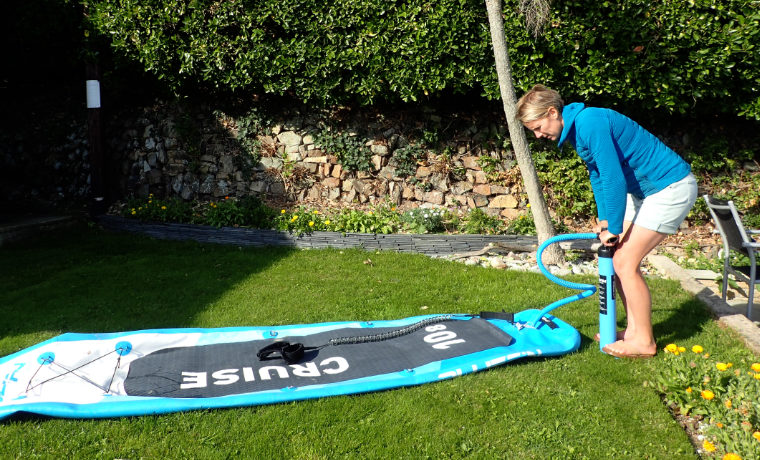 Assuming you are using an inflatable SUP, you should pump your board up to about 12-16 psi or as recommended by the manufacturer. Your board may look and feel inflated at a lower pressure, only for it to bend when you stand on it.
Assuming you are using an inflatable SUP, you should pump your board up to about 12-16 psi or as recommended by the manufacturer. Your board may look and feel inflated at a lower pressure, only for it to bend when you stand on it.
Use a pressure gauge (most SUP pumps have them) to ensure your board is correctly inflated. However, there is no need to exceed the recommended board pressure as it does nothing for stability and could damage the board.
02Put on the fins
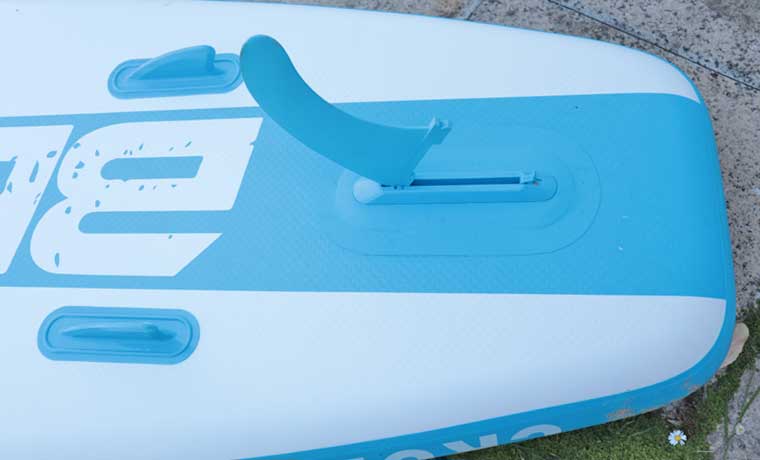 SUP boards have fins to help them stay straight. Most are removable for easier storage. Once your board is inflated, fit the fins and make sure they’re secure. Many beginners have forgotten to attach their fins, only to wonder why they’re paddling around in circles!
SUP boards have fins to help them stay straight. Most are removable for easier storage. Once your board is inflated, fit the fins and make sure they’re secure. Many beginners have forgotten to attach their fins, only to wonder why they’re paddling around in circles!
03Adjust the length of your paddle
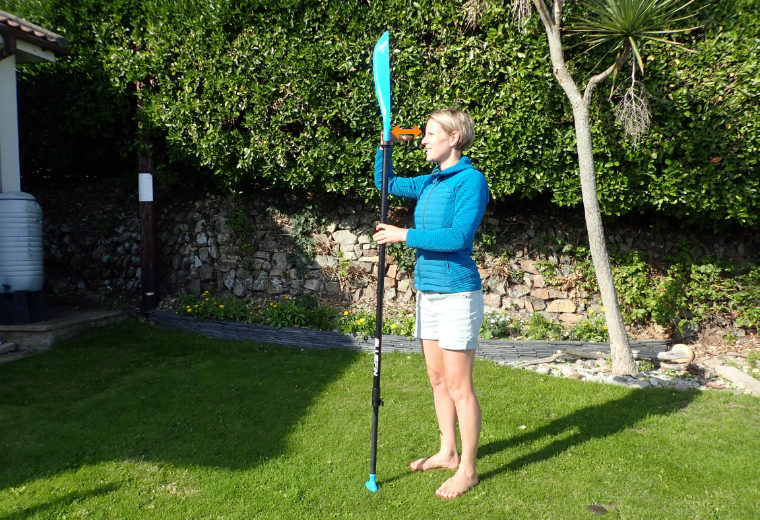 You’ll find it much harder to control your board if your paddle is too short or too long. If it’s too short, you’ll need to squat to get the blade in the water. But, if it’s too long, you’ll have to lift it much higher when you transition between strokes, which is a waste of energy and will disturb your balance.
You’ll find it much harder to control your board if your paddle is too short or too long. If it’s too short, you’ll need to squat to get the blade in the water. But, if it’s too long, you’ll have to lift it much higher when you transition between strokes, which is a waste of energy and will disturb your balance.
So, to ensure your paddle is the correct length, hold it vertically with the handle resting on the floor. Next, extend the paddle until the bottom of the blade is level with your eyes. This should mean the paddle is now about 6-8 inches longer than you are tall.
You’ll probably need to fine-tune the length of your paddle as you become more proficient, but this is a good method to get you started.
04Put on your leash and buoyancy aid
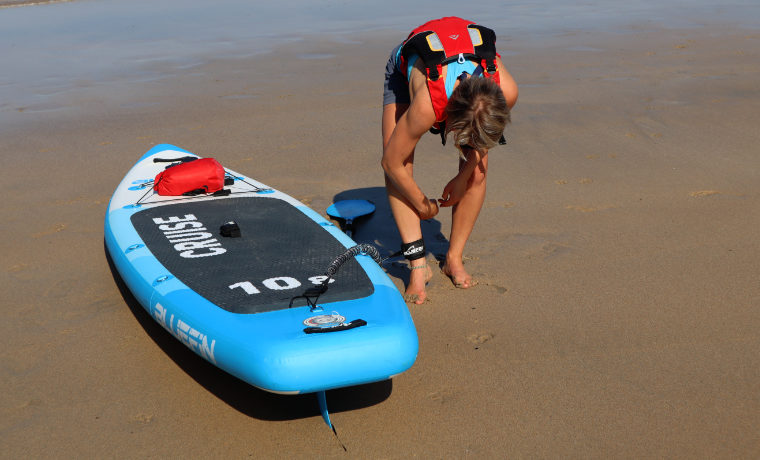 Do this just before getting on the water. Get into this habit, and you’ll never forget to wear your leash. Do the same with your life jacket.
Do this just before getting on the water. Get into this habit, and you’ll never forget to wear your leash. Do the same with your life jacket.
05Pick up your board and take it to the water
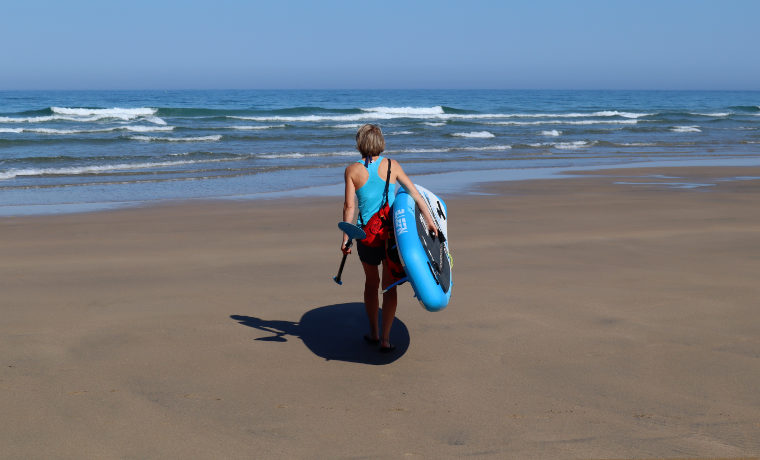 Paddle boards are large and unwieldy, making them tricky to carry. But they’re also pretty light, so if you use the correct technique, it’s not usually too much of a challenge.
Paddle boards are large and unwieldy, making them tricky to carry. But they’re also pretty light, so if you use the correct technique, it’s not usually too much of a challenge.
Stand next to the middle of your paddle board. Place your board on its side, centre handle facing away from you. Reach down and grab the handle.
Using your legs and not your back, stand up and clamp the board between your straight arm and your body. You can carry your board one-handed, leaving your other hand free for your paddle, or, if it’s breezy, put your free hand on top of the board to stabilise it.
How to stand up paddle board for beginners
While you could just jump on your board and hope for the best, you’ll do better if you follow a logical sequence of steps designed to take you from kneeling to standing. Use these SUP techniques for beginners to make learning to paddleboard much easier.
Knee-sy does it!
You’ve probably heard the expression, “you should walk before you run.” The paddle boarding equivalent of this expression is, “you should kneel before you stand.” Kneeling lowers your centre of gravity, making you much less likely to fall off. It’s also easier to get onto your board using your knees.
- Put your board on the water and push it out until the fins are clear of the bottom. The water will probably be knee-deep at this point. Stand next to your board and hold your paddle in both hands.
- Put your hands flat on the board with your paddle beneath to keep it secure. Lift your inner leg and place your knee on the far side of the board, just in front of the central handle. This handle is your board’s balance point.
- Bring your other knee up and rest it on the opposite side of the board. You should now be on all fours with your weight spread evenly from left to right and front to back. Push off your arms and kneel upright.
How to stand on a paddle board
Once you’re used to paddling on your knees, it’s time to stand up. After all, it’s called a stand-up paddle board, not a kneel-up paddle board, right?!
However, only stand up when you feel confident and ready to do so.
Also, wait until you are in reasonably deep water before you try to stand up. That way, if you fall off, you won’t hit the bottom and hurt yourself. Chest-deep water is about right.
It’s easier to stand up on a moving paddleboard as, like riding a bike, speed helps create stability. So, do 3-5 good strokes while kneeling before attempting to stand up.
Follow these steps to go from kneeling to standing:
- To stand up, return to all fours with your paddle in your hands. Rest on your closed fists.
- Next, lift your knees off the board and step or hop your feet forward so they’re either side of the central handle and out near the edge of your deck pad.
- Push off your arms and stand up as smoothly as you can.
- Stand up straight with your knees slightly bent, abdominals lightly braced, and look straight ahead.
- Try to maintain your forward momentum and, therefore your stability, by getting straight back to paddling.
How to hold a SUP paddle and paddling basics
- Place one hand on the top of your paddle, the T-handle, and the other further down, so they’re about 1.5 shoulder-widths apart. Reach forward and plant the paddle in front of you, so it’s roughly vertical.
- Then, and without bending your arms too much, pull the paddle back toward your feet. Keep the paddle close to the board to ensure you travel in a straight line. Remove the paddle from the water, swing it forward, and repeat.
- To change sides, which is necessary for keeping you straight, turning, and making sure you aren’t just using one side of your body, bring the paddle in front of you and take your hand off the T-handle and bring it close to your other hand. Then, move your lower hand up, grab the T-handle, and resume paddling on the other side.
- This may feel awkward at first, but with a bit of practice, you’ll be able to change sides without thinking about it. Get used to this manoeuvre by doing a few strokes on your left side and then a few on the right. You can also rehearse this skill on dry land.
How to get on a paddle board after falling in
Falling in is part and parcel of learning to paddle board. It’s not a question of if it will happen, but when. So, get used to the idea and don’t worry about it. Even experienced paddle boarders fall in from time to time.
The key to falling off safely is to fall away from the board. Falling into water rarely hurts, whereas falling onto the board does.
Remember, you are connected to your board by your leash, so you’ll never be more than a couple of metres from your SUP, and your lifejacket will ensure that you don’t sink like a stone.
Also, try to keep hold of your paddle. It’s unlikely you’ll lose it when you fall in, but it’ll save you from having to swim after it.
Once you are in the water, you need to remount your board and resume paddling. There are a couple of ways to do this:
- Firstly, swim up to the side of your board and place one hand on the nearest edge and the other on the far side. Then, push down with your nearest hand, pull with the other, and drag yourself back onboard.
- Once your upper body is on the board, swing your legs around and get back onto all fours. Then you can transition from kneeling to standing as described above.
- Alternatively, you can swim up to the end of your board, place your hands on either side of the tail, and simultaneously push down and drag yourself back on the board.
Try both options and see which one feels easiest.
Remember to get your paddle either before or shortly after remounting your board. Most are made to float but are only buoyant for a few minutes. After that, the foam inside can become waterlogged, and it may start to sink.
Turning your paddle board
Providing you paddle evenly, your board should travel pretty straight. However, if there is a current or strong wind, you may need to paddle more on one side than the other to stay on course.
But, you can’t just go in a straight line; you also need to be able to turn your paddle board.
- To do this, you can simply move your paddle out and away from your board and do what’s called a sweep stroke.
- However, if you want to turn faster, you may need to do a reverse stroke on the opposite side of your board.
- Combining sweep strokes on one side with reverse strokes on the other is often the fastest way to initiate a turn.
Heading back to shore
All good things must come to an end, and that includes your paddling trip.
- Head for shore, approaching at a right angle to where you plan on landing.
- As you near the shore, move carefully from standing back to kneeling. The water will be getting shallower, and a fall in shallow water can be very painful. Plus, when your board stops on the shoreline, this will save you from pitching forward and landing on your face!
- Try to come to a halt before your board hits the bottom to avoid damaging it. Then, just climb off, tuck your board under your arm, and return to terra firma.
Paddle boarding tips and tricks for beginners
The best way to become a proficient paddleboarder is to learn by doing. Every trip out on the water will teach you something new. But here are a few SUP tips that should help you go from beginner to pro more quickly.
01Keep your knees slightly bent
Slightly bent knees make it easier to shift your weight and adjust your balance. This doesn’t mean paddling in a semi-squat position. Instead, just unlock your knees, so the joints are “soft” and have some give in them.
02Brace your abs
Keeping your abs braced will make you a more efficient paddler. To brace your abs, just lightly contract them so you can feel them working. You should still be able to breathe normally, even with your abs braced.
03Spread your weight between the balls of your feet and your heels
Make sure you can wiggle your toes and that your weight is spread evenly through from the balls of your feet to the heels. This will improve your balance and minimise foot pain, a common complaint among paddle boarders. Avoid putting too much weight on your heels as this usually leads to falling backward.
04Head up, look at where you want to go
If you look down, your body tends to incline forward, making it harder to maintain your balance. Avoid this problem by keeping your head up. Look in the direction you want to go and not at the nose of your board.
05Use your whole body to paddle
Believe it or not, paddle boarding is a full-body activity. Paddling with just your arms is inefficient and tiring. You’ll go further, faster, and with less effort, if you learn to spread the strain across all your major muscle groups.
Focus on keeping your arms relatively straight, turning your shoulders and waist, and pushing your feet forward rather than pulling the paddle backwards. While this all might sound a bit weird, these techniques will have a huge impact on your SUP beginner performance.
Paddle boarding for beginners – wrapping up
Paddle boarding is a popular and rapidly growing activity. It’s one of the most accessible ways to get out on the water.
There are lots of different ways to enjoy paddle boarding, from cruising quiet inlets and lakes to touring, racing, and even surfing. It’s an ideal activity for families, and, providing you use your common sense and take a few basic precautions, it is very safe.
Unsurprisingly, the most challenging part about learning to paddle board is standing up. It looks and feels so unnatural! But paddle boards are made to be stood on, and after a bit of practice, you’ll soon get the hang of it.
So, use the information in this article to get a grip of the basic techniques, and then head for the water. You’ll be on your feet and paddling like a pro in no time!
Interested in starting some other outdoor activity? Check out our beginner guides.
The post Paddle Boarding for Beginners: A How-to Guide appeared first on Cool of the Wild.


